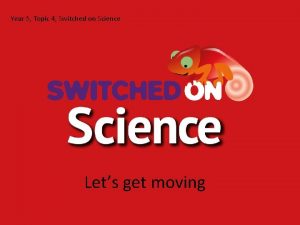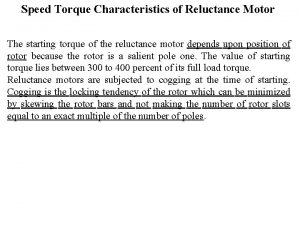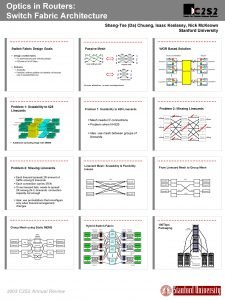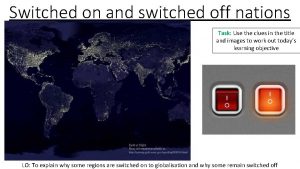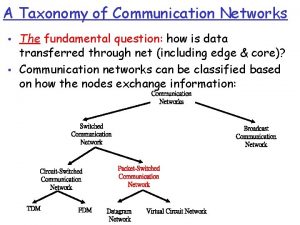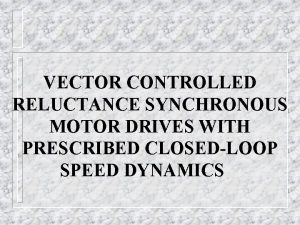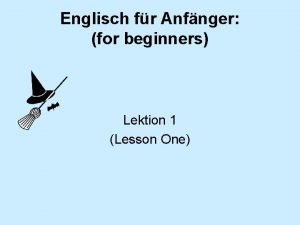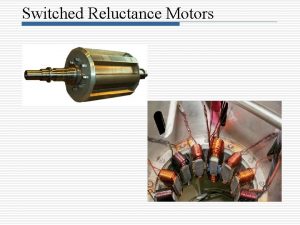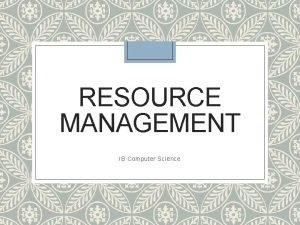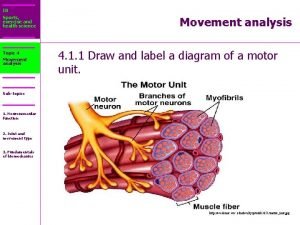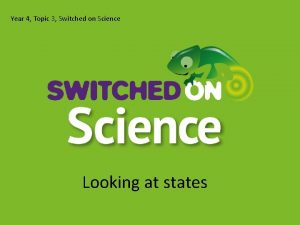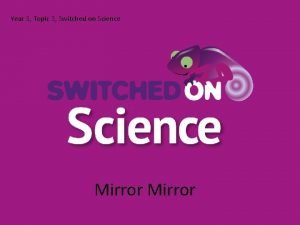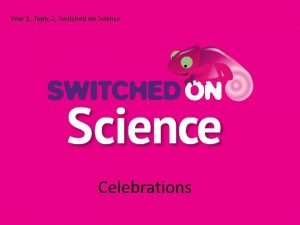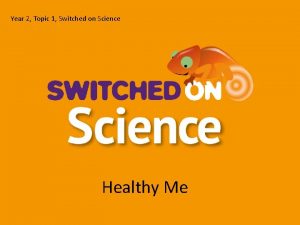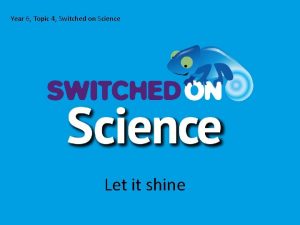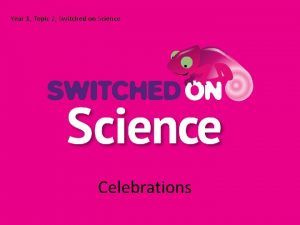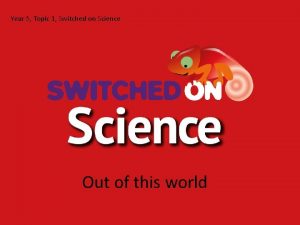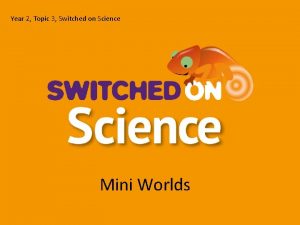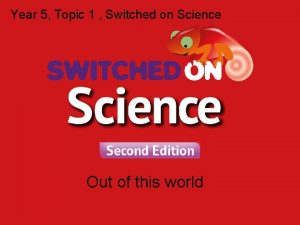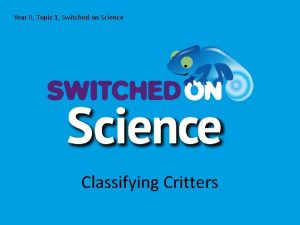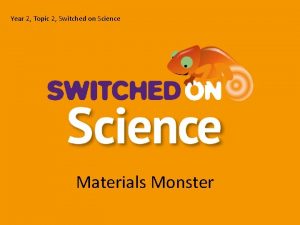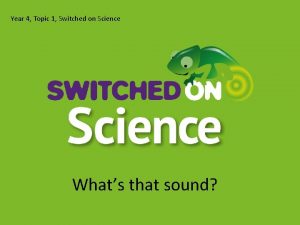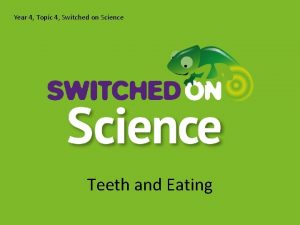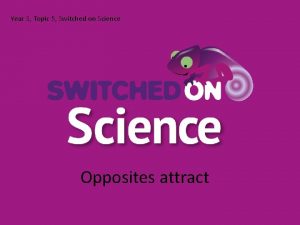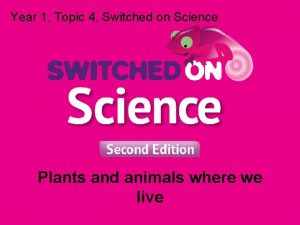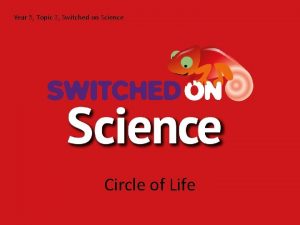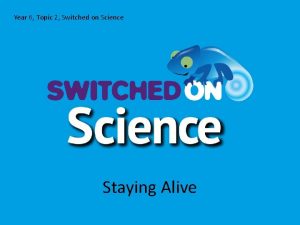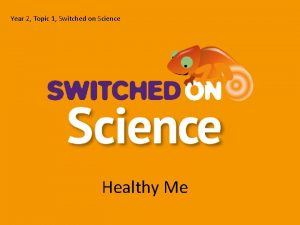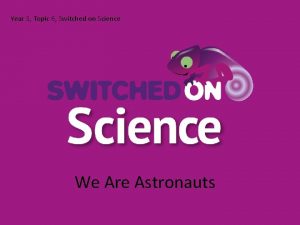Year 3 Topic 2 Switched on Science Food






































- Slides: 38

Year 3, Topic 2, Switched on Science Food and Our Bodies

Key Vocabulary • • Nutrients Protein Fat Balanced Diet Carbohydrates Skeleton Femur Humerus • • • Exoskeleton Contract Relax Muscle Joint

In this topic you will: • • Find out about healthy and balanced diets Find out about the parts of the skeleton Compare animals with and without skeletons Look at bones, joints and how muscles help us move

Quick teaser • Who has the most bones in their neck; a human or a giraffe?

Answer • A human and a giraffe have exactly the same number of bones in their neck. • A giraffe just has much bigger, longer bones.

Did you know? • The tongue of a giant anteater is over 60 cm long and covered in sticky saliva. They poke them deep into ant hills and snatch up the ants that stick to them.

Let’s think like scientists • Do all animals eat the same food? • What would happen if we didn’t have skeletons? • How are animals with tough external skeletons able to move about? • What muscles are used when you kick a football? How about when you do a high jump?

Why is it difficult for an athlete to be good at many different events, such as in a decathlon or triathlon, rather than just one sport?

Pet foods • What different foods do your pets eat? • Could you describe what they eat? • Does a guinea pig eat the same food as a goldfish? • Do some of your pets eat the same food all the time?

Herbivores and Carnivores • Some animals only eat plants. They are called Herbivores. • Some animals only eat meat. They are called Carnivores. • Write down as many animals as you can. • Which are Herbivores and which are Carnivores?

Design a menu • Design a dinner menu for an animal such as a meerkat, a lion or a crocodile. • Find out what foods it eats. • Design a dinner menu for your animal

Quick challenge: • Why do people who run marathons eat lots of pasta the night before the race?

Food for thought • Think about all the different types of food that you eat. • Could you sort them into groups of similar foods?

Food Groups Starchy foods Fruit and vegetables Proteins Milk and dairy Fat and sugar

Food Groups • Starchy Foods: Provide us with energy. • Fruit and vegetables: Minerals and vitamins to stay healthy. • Milk and dairy: Calcium for healthy bones. • Fat and sugar: Provides energy. • Proteins: Helps us to grow.

Sort foods into different groups. Some foods might appear in more than 1 column.

Sugary Drinks • Which drinks contain the most sugar? • How could you find out?

Balanced Diet • A balanced diet is a diet that has the right amount of nutrients. It has a good mix of all the different food groups.

Skeletons • Which bones do you know about? • How many bones can you name?

Point to your…. • Skull • Ribs • Backbone • Collarbone • Humerus • Femur • Pelvis

X-Rays • An X ray photograph lets us see the bones inside our body. • Which part of the body is this? • Can you feel any of these bones in your own body?

Challenge • Look at this knight in armour. • Why is he dressed like this? • What does the armour do? • What would it be like to wear this?

Why do we have skeletons? • Why do you think we have a skeleton? • What jobs do you think our skeleton does? • What would it be like if we didn’t have a skeleton?

Our skeleton • protects our organs • supports our bodies • helps us to move.

Fish Frog Pigeon Snake

Exoskeletons • Some animals have their skeletons on the outside, like a suit of armour.

• And some animals don’t have a skeleton at all…

Animal Skeletons • Can you think of five more animals that: – have a skeleton inside their bodies? – have a skeleton outside their bodies? – don’t have a skeleton at all?

Muscles • Think about all the different sports that you might see at the Olympics. • How many different ways do athletes use their bodies? • Which muscles are working hardest for each one?

Arm Muscles • • Muscles work in pairs. Muscles only pull. They don’t push. The Biceps muscle pulls your arm up. The Triceps muscle pulls it down.

Model Arm Triceps – pulls the arm down Biceps – pulls the arm up

Muscles contract and get shorter.

Bend and Flex • Mime different actions: kick a football, wave goodbye. • Point to the parts of the body that bend to allow you to move.

Joints • Joints are the places where our bones meet. • They allow the skeleton to move. • There are different types of joint in our bodies, each allowing different types of movement.

Joints • Investigate the movement of different joints in your body. • Write down how they move. • Are they all different? Which joints are the same? • Which real life objects move the same way?

Hinge joints • Our elbows and knees are hinge joints. • They allow simple movement back and forth.

Ball and Socket Joints • Our shoulders and hips are ball and socket joints. • This allows movement in several directions.

• Sliding joints – like the ankle and wrist, allow for a little bit of movement at the joint. • Fixed joints are where the bones are joined and do not move, like the bones in our skull. joints
 Advantage of circuit switching
Advantage of circuit switching Switched on science
Switched on science Switched on science
Switched on science As a child which subjects of science was your favourite
As a child which subjects of science was your favourite Examples of clincher sentences
Examples of clincher sentences Broad and specific topic examples
Broad and specific topic examples Unit 2 food food food
Unit 2 food food food Food chain sequence
Food chain sequence Switched digital video
Switched digital video Switched cap building block
Switched cap building block Torque speed characteristics of switched reluctance motor
Torque speed characteristics of switched reluctance motor Switched fabric architecture
Switched fabric architecture Circuit switched wan
Circuit switched wan Backbone network architectures
Backbone network architectures Why is north korea switched off from globalisation
Why is north korea switched off from globalisation Switched ethernet vs shared ethernet
Switched ethernet vs shared ethernet Charge pump converter
Charge pump converter Public switched telephone network diagram
Public switched telephone network diagram Pengertian circuit switching
Pengertian circuit switching Public switched telephone network diagram
Public switched telephone network diagram Pstn
Pstn Pstn
Pstn Slotted optical switches
Slotted optical switches Drei schweizer hexen
Drei schweizer hexen Cisco borderless networks
Cisco borderless networks Taxonomy of switched networks
Taxonomy of switched networks Switched reluctance motor
Switched reluctance motor A switched wan is normally implemented as a network
A switched wan is normally implemented as a network Introduction to network management
Introduction to network management Switched witches
Switched witches Packet switching system
Packet switching system Introduction to switched networks
Introduction to switched networks Torque speed characteristics of switched reluctance motor
Torque speed characteristics of switched reluctance motor Hendershot
Hendershot Bcmsn
Bcmsn Funny year 6 leavers poems
Funny year 6 leavers poems Ib computer science topic 6
Ib computer science topic 6 Ib sehs topic 4
Ib sehs topic 4 Ib computer science topic 1 questions
Ib computer science topic 1 questions

